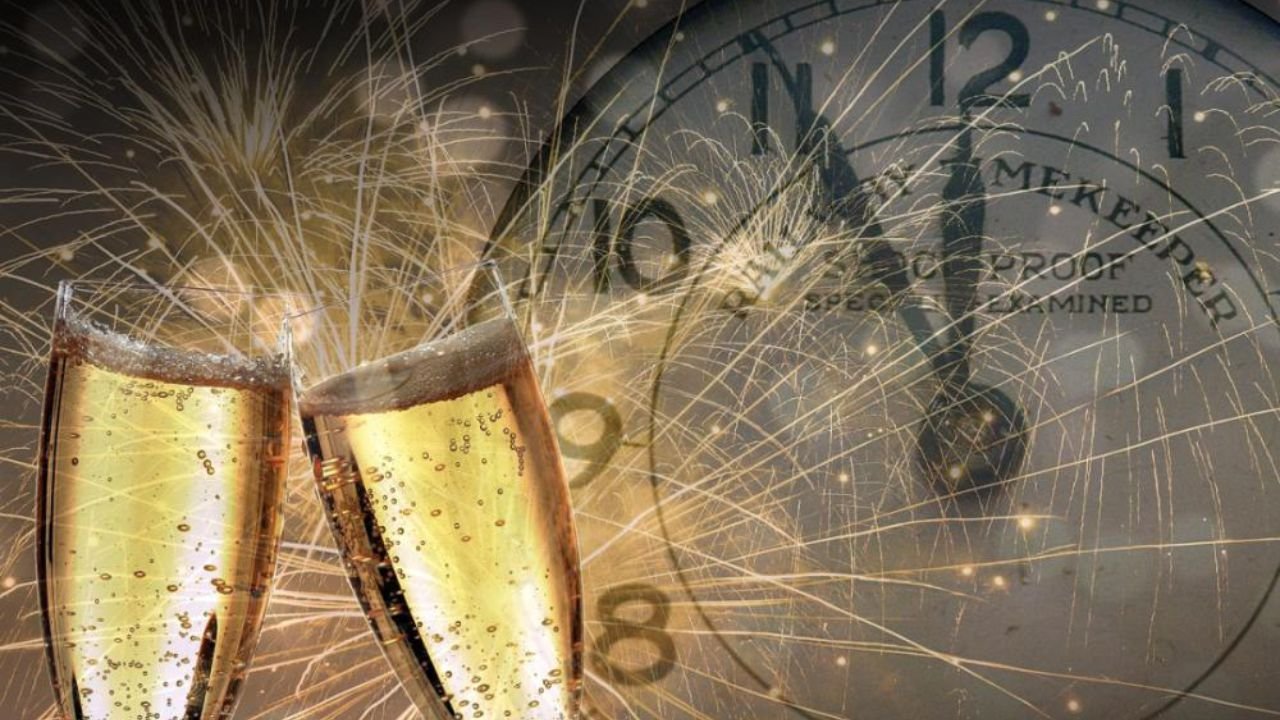And another year has passed. There are many New Year’s Eve customs on the last day of the year. All over the world, there are typical traditions at the end of the year. Toast with sparkling wine, shoot fireworks in the sky, eat fondue or raclette – the list goes on and on.
The following also applies: New Year’s Eve customs couldn’t be more different. What are you doing? Pouring lead or fireworks? We introduce you to the most diverse New Year’s Eve customs that have become established around the world: funny, bizarre, superstitions, and other traditions with which you can start the new year …
- New Year’s Eve customs
- Superstitious New Year’s Eve customs
- Why do we let it pop properly on New Year’s Eve?
- Customs and rituals: why do we celebrate New Year’s Eve?
- New Year’s Eve customs from around the world: This is how others celebrate New Year’s
- New Year’s Eve customs in Argentina
- New Years Eve Customs in Australia
- New Year’s Eve customs in Brazil
- New Year’s Eve customs in Bulgaria
- New Year’s Eve customs in China
- New Year’s Eve customs in Denmark
- New Year’s Eve customs in Ecuador
- New Years Eve Customs in England
- New Year’s Eve customs in France
- New Year’s Eve customs in Greece
- New Year’s Eve customs in Israel
- New Year’s Eve customs in Italy
- New Years Eve Customs in Japan
- New Year’s Eve customs in the Netherlands
- New Year’s Eve customs in Austria
- New Years Eve Customs in Portugal
- New Year’s Eve customs in Romania
- New Year’s Eve customs in Russia
- New Year’s Eve customs in Switzerland
- New Year’s Eve customs in Slovakia
- New Year’s Eve customs in Spain
- New Year’s Eve customs in South Africa
- New Year’s Eve customs in the Czech Republic
- New Years Eve Customs in the United States
- Why do you wish a “happy new year”?
New Year’s Eve customs

Numerous New Year’s Eve customs are celebrated in almost every household. Some families take every tradition with them on New Year’s Eve, others limit themselves to one or two selected customs. Here is a selection and overview of the most popular, of which you are guaranteed to have already taken part:
lead-pouring
The pouring of lead with real lead is prohibited in this country for health reasons. The custom is continued with tin or wax and is popular with children. A small tin figure is melted over a candle and poured into cold water. With the shape that forms in the water, a shadow is thrown on the wall and thus the future for the coming year is interpreted.
Lucky charm
Horseshoes, lucky pigs, or chimney sweeps are often given away as talismans and should start the new year off well.
fondue
In addition to raclette, the fondue is a classic New Year’s Eve meal. Together with family and friends, you sit at a table, in the middle a saucepan with hot fat in which food is fried. Unlike on Christmas Eve, you have time on New Year’s Eve. It doesn’t have to be fast, you just wait and let the year end comfortably.
dinner for one
“The 90th Birthday” is a TV production by NDR from 1963. This is a sketch celebrating the birthday of Miss Sophie, played by May Warden.
She celebrates this every year in the same way and with the same guests. But all her friends have died and so the old butler James, played by Freddie Frinton, has to step in. Probably the most famous sentence of the sketch: “The same procedure as last year?”
Nudge
Three, two, one – the countdown is over, and at exactly zero o’clock your toast with a glass of champagne and the words “Happy New Year”. But what does “Prosit” actually mean? The term comes from Latin and means translated: “May it succeed”. And how do you toast properly? The glass is taken by the stem, that’s the only way it sounds.
Never bump the glasses together at the upper edge – that is the weakest point, the predetermined breaking point, so to speak. The danger that there will be broken pieces is too great here. It is ideal to hold the glasses at an angle of 10 degrees and to bump them on the stomach with a gentle * thing *.
New year donut
As soon as the new year has started, there is a sweet tooth in this country – in the form of New Year’s Berliners or donuts. They are traditionally filled with jam, fruit puree, or liqueur. The custom has also developed to fill some of them with mustard. Not a good omen if you catch the nasty jam alternative.
Superstitious New Year’s Eve customs
No laundry
According to belief, the god Wotan wandered around with his ghost lord on New Year’s Eve – and can get caught in hanging laundry and get stuck. Since you don’t want to find the god of the dead and the storm in your garden or laundry room, you shouldn’t do your laundry after New Year’s Eve.
No poultry
Anyone who annoys poultry at the end of the year is wasting their luck for the coming year. According to custom, your happiness flies away with the goose if you annoy them (or other poultry) on the last day of the year. This also includes eating poultry – after all, the animals are sure to be upset about it.
Eat lentils
Is it going to be good financially next year? According to a New Year’s Eve, you should then eat lentil soup. According to custom, the lenses symbolize the coins that you can look forward to in the coming year. You are welcome to take a second portion when you eat.
Keep fish scales
Carp is a traditional New Year’s Eve dish. A superstitious custom: hold a fish scale and place it in your wallet. According to a New Year’s Eve custom, this ensures that you will never run out of money in the New Year.
No unfinished tasks
If you still have a few tasks to do, you should either finish them before the turn of the year – or start doing them in the new year. Taking unfinished tasks into the new year is believed to only bring more work. So get ready beforehand or wait a few more days before you start.
Welcome 2025 with amazing new year gifts online by MAKHAN
Why do we let it pop properly on New Year’s Eve?
Black powder, and thus the origin of fireworks, is in China, where it has been used to fire arrows, i.e. rockets, since the 8th century. It was not until 500 years later that black powder came to Europe through Dutch seafarers. The first real fireworks display is dated to 1506, which Maximilian I had ignited over Lake Constance during the Reichstag in Constance.
The fact that we ignite rockets and firecrackers on New Year’s Eve goes back to the custom. At the turn of the year, they drove away evil spirits and demons with a great noise. At that time they still used rattles or whips. From the 15th century, black powder was also used to fire rifle shots.
In the centuries that followed, noble houses used the early forms of fireworks to demonstrate wealth and power. Fireworks only became accessible to the general public in the 19th century. Despite this ancient tradition of fireworks, it has only been the custom since the early 20th century to celebrate New Year’s Eve with rockets and firecrackers.
Customs and rituals: why do we celebrate New Year’s Eve?
Originally “New Year’s Eve” was a male given name. December 31st is named after Pope Silvester I because he died on this very day in 355.
Probably nobody would know that today if the Gregorian calendar had not been introduced in the 17th century. This changed from the beginning of the year to January 1st. From then on, the old year was said goodbye and the news was celebrated on New Year’s Eve.
We have always met transitions, such as school leaving certificates or birthdays, with a mixture of joy and fear. The turn of the year also represents such a transition. This is why various New Year’s Eve customs and rituals have developed over time. Above all, they are supposed to drive away evil spirits, banish insecurities and ensure happiness.
New Year’s Eve customs from around the world: This is how others celebrate New Year’s
Fondue and lead pouring? These customs are of course a part of New Year’s Eve. Internationally, however, New Year’s Eve customs are completely different.
Did you know, for example, that the Czechs question the apple oracle on New Year’s Eve to predict their future? We have put together a list of funny and bizarre New Year’s Eve customs from all over the world and explain how the New Year is celebrated there:
New Year’s Eve customs in Argentina
The Argentines have a particularly original way of getting rid of old documents: They make scraps of paper out of them on the last anniversary and throw the confetti out of the window on New Year’s Eve – and thus symbolically all the contaminated sites.
Another New Year’s Eve: Eat twelve grapes (the Spanish and Portuguese do too). To this end, people usually meet in public places. The grapes are consumed at midnight, grape by grape, with every stroke of the bell.
New Years Eve Customs in Australia
The Australians treat themselves to the longest fireworks in the world. It is ignited at the world-famous opera in the harbor and lasts a proud twelve minutes. Every minute stands for one of the past months.
New Year’s Eve customs in Brazil
At Copacabana, the residents of Rio de Janeiro throw flowers into the sea on New Year’s Eve. If they drown in the sea, the wish for the next year will come true, if the waves wash the stems back onto the beach, the request is deemed to have been rejected.
When it comes to underwear, the body-hugging South Americans like it colorful: Those who wear red lingerie want more passion in bed, pink stands for more love, yellow for more money, and white for peace and harmony.
New Year’s Eve customs in Bulgaria
The Bulgarians fight into the new year – literally. With blows on the back, the new year is whipped in an sch (m) ore-like manner. To do this, a branch of the cornel cherry tree is first decorated and then transformed into a rod (“Surwatschka”).
With this, the children go from door to door at the turn of the year and blow their grateful neighbors over with it. They then cherish the hope that the infantilized flogging may bring them wealth and health in the new year.
New Year’s Eve customs in China
The Chinese celebrate on New Year’s Eve: nothing. Your New Year doesn’t start until February. Then the house is cleansed of evil spirits with bamboo branches and everything is renewed: bedclothes and clothes.
The house is still adorned with red strips of paper and golden symbols of good luck, and in some places, single people throw mandarins into the sea – so that they can no longer stay single and find a spouse. Shortly before the New Year starts, from 11 p.m., all windows are opened to let in the New Year.
New Year’s Eve customs in Denmark
First of all, the Danes smash old dishes on New Year’s Eve. They throw the old porcelain on the doorstep of the person they want to wish good luck to.
At the turn of the year, they finally jump from their chairs. No joke! At midnight on the dot and with the first stroke of the clock, the Danes jump from a chair and symbolically jump into the New Year. There is also the Queen’s New Year’s address on TV.
New Year’s Eve customs in Ecuador
The New Year’s Eve custom is particularly bizarre among South Americans: at midnight, they fill dolls with bangers and set them on fire. Most of the time the dolls show witches or evil spirits. But sometimes also politicians and other public figures who then explode to get rid of them.
New Years Eve Customs in England
The British let it bang too – albeit less privately, but organized through large fireworks, for example on the “London Eye” Ferris wheel. The real fireworks day is November 5th in the British Isles.
On that day, the officer Guy Fawkes attempted an assassination attempt on King James I. “Hogmanay”, on the other hand, is called New Year’s Eve in Scotland.
Anyone knocking on the door with whiskey, raisin bread, and a piece of coal under their arm must be allowed into the house. This also supposedly brings luck and guests anyway.
New Year’s Eve customs in France
The French take it easy. There are hardly any fireworks here, at most on the Parisian Champs-Elysées. The French meet friends for dinner on New Year’s Eve, drink champagne, and enjoy foie gras (goose liver) and oysters. Bon Appetit!
New Year’s Eve customs in Greece
The so-called basil bread is served here on New Year’s Day. Like a lucky charm, the baker baked a coin beforehand. Those who find the coin can hope for a windfall in the new year. The Greeks are also passionate about gamers and gamblers.
Card and dice games at home with friends, relatives, and family are just as popular as a visit to the casino. And there is a reason for that: The Greeks believe that whoever wins that evening will be lucky for the rest of the year.
New Year’s Eve customs in Israel
“Rosh Ha Shana” is the name of the beginning of the year in Israel and is introduced with a loud hoot of a ram’s horn. The piercing horn sound is intended to exhort people to repentance and conversion. The din is sweetened by apples with honey, honey cake, or a sweet carrot dish called “Meren” in Yiddish.
New Year’s Eve customs in Italy
The fiery Italians live up to their reputation on New Year’s Eve: red underwear is essential here. Regardless of the variant – red lingerie is a must for both women and men. That should bring luck, but above all love luck. Lentils are traditionally eaten after midnight – because of their shape, they represent a wealth of money.
New Years Eve Customs in Japan
Similar to the Chinese, the Japanese clean their houses to a shine shortly before New Year’s Eve. At midnight on the dot, the temple bells strike 108 times across the country – to drive away from the 108 evils of the people and the old year. On New Year’s Eve, dumplings are made from glutinous rice (“mochi”) and eaten on New Year’s morning. That should bring about a long life.
New Year’s Eve customs in the Netherlands
A cabaret show is traditionally watched on television in the Netherlands during the evening. This is called the “Oudejaarsconference”. The show is entirely political: what is being said here will be in all the newspapers the next day. There are also “Oliebollen” (donuts with or without raisins) and “Appelflappen” (fried apple donuts), both very fatty and very delicious. At the turn of the year, there are three cheek kisses from everyone you meet.
New Year’s Eve customs in Austria
Further northeast, in Vienna there is traditional dancing – of course: waltzes. Even in the clubs and discos, you can hear the Blue Danube Waltz at noon. The firecrackers are lit in front of St. It is just stupid that the Viennese also maintain the custom of then smashing the empty bottles on the cobblestones – instead of bangers. This not only ensures broken glass that is said to bring good luck but also increases the risk of injury.
New Years Eve Customs in Portugal
The Portuguese hope that the new year will bring them more financial happiness. To do this, they hold a coin in their hand at midnight. Some also throw the penny in the doorway. But only on your own! Otherwise, the windfall will go to the other house. The last meal of the year cannot be poultry here either. The good of the new year could fly away.
New Year’s Eve customs in Romania
In Romania people believe that stroking a lamb, also known as “Vasilica”, should bring good luck. That’s why on New Year’s Eve you see many children in the streets and markets of Romania with lambs under their arms, which you can pet for a small fee.
New Year’s Eve customs in Russia
The turn of the year marks the beginning of a ten-day break for the Russians, where everyone gives each other presents. The Orthodox Church does not follow the Gregorian calendar, but the Julian calendar – and Christmas falls on January 7th and New Year on January 13th. That’s why ten days.
New Year’s Eve customs in Switzerland
In Switzerland, firecrackers and corks pop at the turn of the year. There are also loud parades with hooded figures, drums, bells, and the cracks of a whip. Because the New Year’s Eve tradition wants evil spirits and demons to be driven away with all sorts of noise at the turn of the year – with the so-called “Archetringele”.
On the New Year, the young men in a village transform themselves into the characters “Chindlifrässer”, “Blätzibub” and “Huttefroueli”. They, too, roam the alleys from noon to evening to ward off evil.
New Year’s Eve customs in Slovakia
A relatively new event is on the program in the Slovakian capital, Bratislava. Around 26 years ago, the city introduced the New Year’s Eve run across the city’s bridges. The 10-kilometer route of New Year’s Eve runs across all accessible bridges and along the banks of the Danube.
New Year’s Eve customs in Spain
The Spaniards eat exactly twelve grapes at midnight – one for every stroke of the church clock. But woe betide anyone who miscounts – they are said to be unlucky next year. Therefore, shortly before the turn of the year, supermarkets offer cans with twelve grapes counted.
Before the Spaniards toast with sparkling wine in the New Year, they put a golden ring in the glass – that should also bring good luck (if you don’t swallow the good piece). And like the Italians and Brazilians, the Spaniards – men and women alike – wear red underwear on New Year’s Eve.
New Year’s Eve customs in South Africa
In South Africa, the New Year is like a colorful carnival celebration. The highlight is a parade with drums, costumes, dancers, choirs, and musicians. This tradition goes back to the “Emancipation Day”, on which the slaves were released in 1834.
New Year’s Eve customs in the Czech Republic
The superstitious Czechs traditionally cast lead. But it is also common to divide apples and use the position of the kernels to interpret one’s future: if the kernels form a star shape, everything will be fine – if they form a cross, disaster threatens.
New Years Eve Customs in the United States
The Americans, especially those in the southern states, eat lentils or lentil soup on New Year’s Eve – as money and good luck charm.
Others maintain a kind of self-imposed house arrest on New Year’s Day: Under the motto “Nothing Goes Out”, nobody is allowed to leave the house. Anyone who dares to do it anyway faces a year full of bad luck.
Why do you wish a “happy new year”?
A happy New Year! – that’s what many are currently wishing for at the turn of the year. One is initially inclined to discover a particularly perfidious form of anticipatory malicious pleasure in it. After all, the turn of the year is often accompanied by slush or black ice and by increased alcohol consumption.
What is meant, however, is a kind of sliding into the new year. That probably goes back to the German dictionary of the Brothers Grimm. There is also an explanation for the verb slip. Slipping – that is when someone moves to slide, voluntarily or involuntarily. So whoever slips into the new year is sliding more or less deliberately into a new age.
There are a number of other explanations for the slippery New Year’s greeting. None of them are really convincing. Only this: The word “Rutsch” goes back to the Hebrew “Rosh Ha Schanah”, which in Yiddish or Rotwelchen was shortened to “Rosch”, which in turn sounds very similar to the German “Rutsch” and translated means “beginning of the year”. So if you wish a happy new year, you simply wish each other a good start to the new year.







